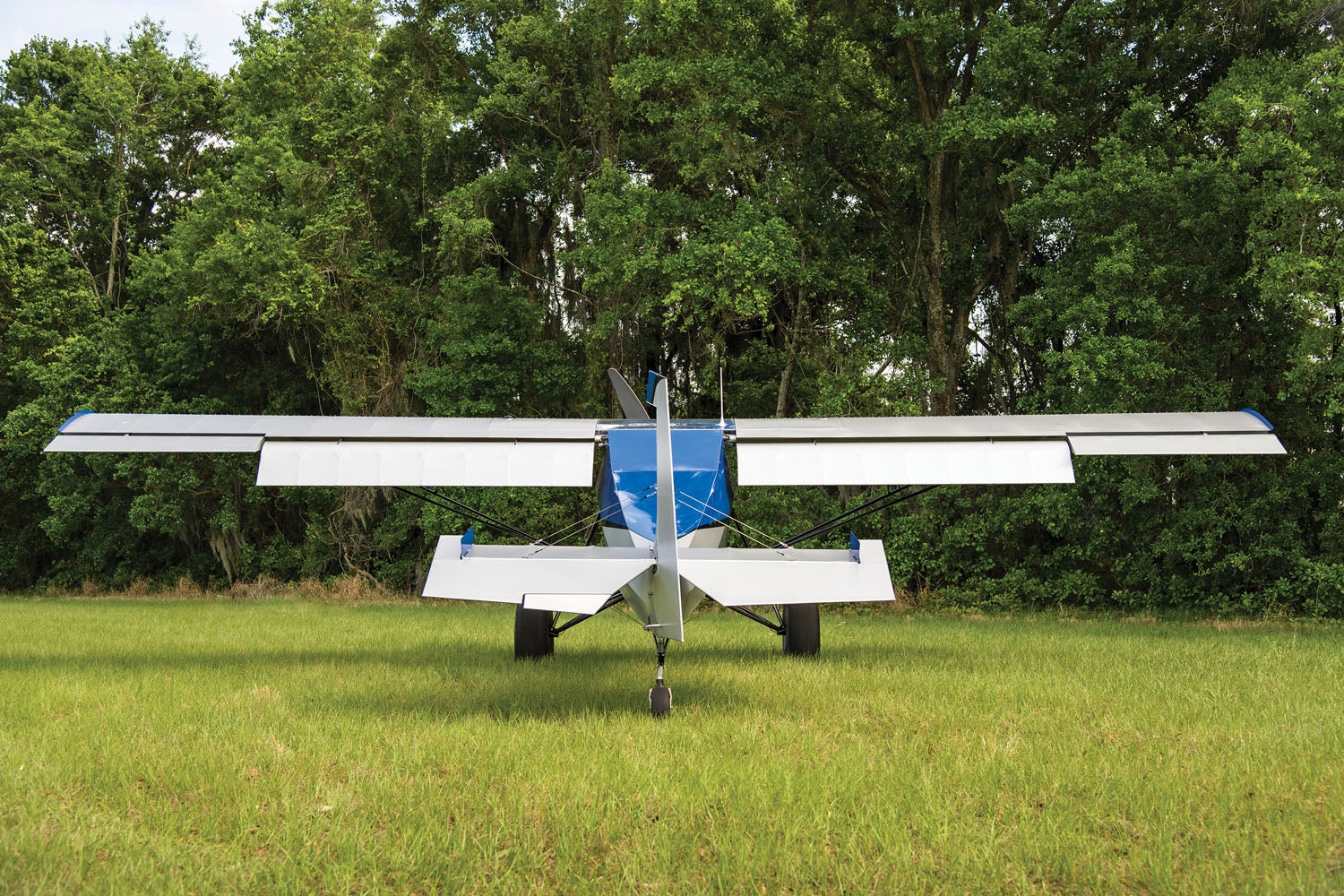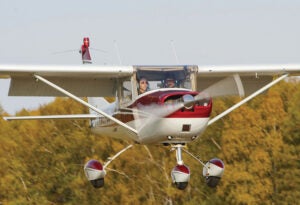Flaps change the geometry of the wing to allow the pilot to change the aerodynamic characteristics of the airplane to match the needs of different phases of flight. Flaps have different effects on takeoff, climb, approach and landing. The proper choice of flap system for an airplane arises from which part of the flight envelope is of greatest importance. The characteristics of the flap system should be matched to the needs of that flight regime.
While details differ from one flap type to another, all flap systems produce some combination of the same set of aerodynamic effects when they are deflected.
First, they increase the lift of the wing at constant angle of attack.
Second, they increase the maximum lift and maximum lift coefficient (CLMAX) the wing can generate.
Third, they change the drag of the airplane.
Deflecting a flap normally increases drag, but for small deflections, particularly for well-sealed plain flaps, this drag increment can be very small. For larger, positive (trailing-edge-down) deflections the drag increase is significant.
A few specialized airfoils use plain flaps to adjust the camber to optimize drag in climb and cruise. On these sections, a small negative (trailing-edge-up) flap deflection can actually decrease drag at cruise conditions.
Last, deflecting flaps down produces a nose-down pitching moment that the tail must oppose to trim the airplane.

Stall Speed
Deflecting flaps increases the lift coefficient (CLMAX) of the wing and reduces the stall speed of the airplane. This can have beneficial effects on both landing and takeoff. It may also be needed to meet regulatory requirements for certified airplanes. As an example, U.S. FAR Part 23 requires that the stall speed of a single-engine airplane in landing configuration not exceed 61 knots. This stall speed requirement drives the maximum wing loading the airplane can have. An airplane certified under Part 23 can have higher wing loading if flaps are used to reduce stall speed in the landing configuration. This can be particularly valuable for fast cross-country airplanes.
Regulations vary, so it’s important to check in what configuration the relevant regulation specifies the stall speed. For example, U.S. Light Sport (LSA) requirements specify a maximum stall speed in cruise configuration. Adding flaps will not help an LSA meet the regulation stall speed. This does not mean that flaps can’t have very positive effects on an LSA, but they don’t play a part in regulatory compliance.
Flap Effects on Approach and Landing
One of the primary reasons to add flaps to a design is to reduce approach and landing speed.
Deflecting flaps increases CLMAX and reduces stall speed. Lowering stall speed reduces approach and landing speed, which in turn reduces the landing roll.
The other function of flaps in the approach is to increase drag. This steepens the approach glide, which reduces the distance the airplane travels in the air between the point where it clears an obstacle and the touchdown point. Approach slope control is often overlooked, but it’s a valuable function of a flap system particularly for a clean low-drag aircraft.
Even a low-wing-loading LSA that cannot use flaps to meet regulatory requirements can benefit from having a lower stall speed and the ability of the pilot to add drag to steepen the approach. This can be particularly true for an airplane designed to get relatively high performance on low horsepower. To get the performance they must be aerodynamically efficient, low-drag designs. This works well in up-and-away flight, but a low-drag airplane cannot fly a steep glide without accelerating, so it’s hard to fly a landing approach and arrive at the runway flying slowly enough so the airplane does not float a long distance in ground effect after the flare. Having flaps that can add a significant amount of drag in approach and landing configuration can cure this issue.
The desirable characteristics of a flap system for landing are a trade-off between what is needed on approach and the ability to successfully execute a go-around after a missed approach. A very high drag flap system may produce a steep approach and a slow touchdown speed but render the aircraft incapable of arresting the descent and climbing away from a missed approach without being reconfigured.
One example of this affecting the design of an aircraft is the venerable Cessna 150. It has flaps that deflect to a maximum of 40°. At full flap a 150 can make a very steep approach and short touchdown but, particularly when flown at or near max gross weight on a warm day, can barely climb at full flap and full power.
A go-around in such a situation is a precarious exercise. The pilot must deal with the combination of low rate of climb, trim pressures on the yoke, and the need to maintain altitude and airspeed at full power. The airplane can barely accelerate with full flaps, so the pilot must gradually retract the flaps to reduce the drag enough to be able to accelerate and climb.
The need to retract flaps to reduce drag creates a difficult piloting situation since the first effect of retracting the flaps is to reduce lift and cause a temporary sink transient. It’s a high workload task for a pilot to maintain altitude and airspeed while reconfiguring the airplane this way.

An airplane that has enough power to drive through the high drag of a powerful flap system can take more advantage of the flaps. The designer can trade this several ways: A high-performance airplane can have a higher wing loading. If STOL is the goal, the flap system can be configured to give the airplane the ability to make very steep short approaches in a high-drag configuration.
Flap Effects on Takeoff
The effect of flaps for takeoff is very different than for landing.
On takeoff the airplane must accelerate past stall speed before rotating and lifting into the air. Typically liftoff speed is somewhere between 1.1 and 1.2 times the stall speed. Since takeoff roll is roughly proportional to liftoff speed squared, reducing liftoff speed will minimize takeoff roll.
Deflecting some flap to reduce liftoff speed can be beneficial for takeoff roll but there is a trade-off. Deflecting flaps adds drag. Accordingly, after the airplane lifts off, its rate of climb will be hurt by the drag of the flap and by the higher induced drag that comes from flying slower.
If the airplane has sufficient power to climb away in this higher drag situation, taking off with some flap deflection will be beneficial. In general, the higher performance the airplane, the more likely it is that it will be designed to take off with some flap deflection.
A high-performance airplane with a high power-to-weight ratio and a high wing loading can benefit significantly from taking off with flaps deflected. The lower liftoff speed reduces takeoff roll and the airplane has an enough power to climb away after liftoff with the flaps in the takeoff position.
Most single-engine light airplanes take off with no flap. All airliners and transports take off with flaps deflected. Regardless of this, the flaps will be at a significantly lower deflection for takeoff than landing.
One special-case use of flaps for takeoff is soft-field operations. For a soft-field takeoff, the lift increment from deflected flaps can be used to offload the wheels early in the takeoff roll. Lightening the load on the wheels reduces the friction drag between the wheels and the soft runway surface. The aerodynamic drag of the flaps is lower than the drag of the wheels on the soft or retarding surface. Even if the drag of the flaps is high, getting unstuck and then accelerating in ground effect to climb speed may be highly beneficial.
This only works at flap settings where the drag of the aircraft at liftoff speed is low enough to maintain altitude and have some excess power to accelerate. Even if it is necessary to somewhat reconfigure the airplane in order to climb, there must be enough excess power for the aircraft to remain airborne after liftoff and not sink back into the runway.
Next month we’ll take a look at some common types of flaps and how they affect the aerodynamics of the airplane.













